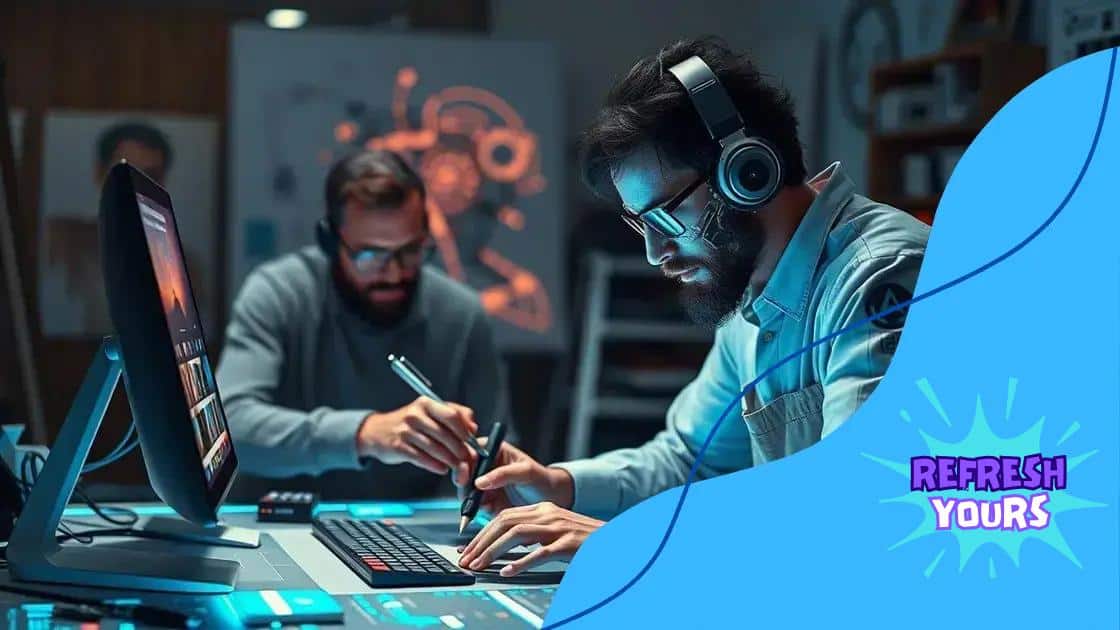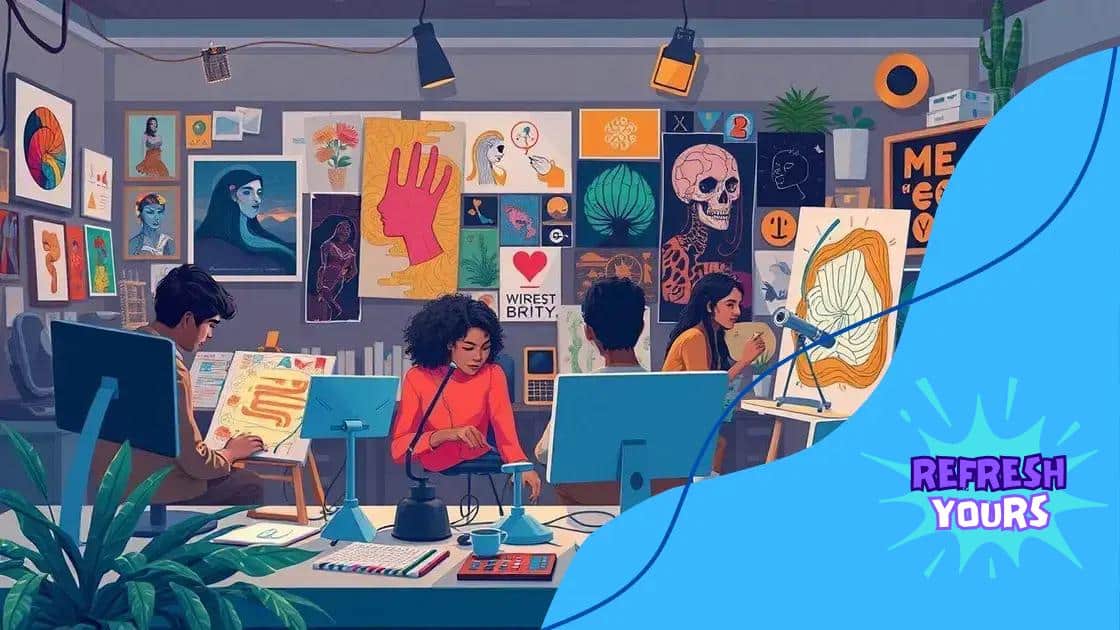The role of AI in transforming the creative industries

The role of AI in transforming the creative industries includes enhancing artistic collaboration, personalizing content creation, and automating repetitive tasks, thereby allowing artists to expand their creativity and innovate in their fields.
The role of AI in transforming the creative industries is becoming increasingly apparent. Have you noticed how technology is changing creativity? In this article, we will look at the different ways AI is influencing artists and creators today.
Understanding the impact of AI on creativity
Understanding how AI affects creativity is crucial in today’s digital world. It’s intriguing to see how machines can collaborate with human artists, providing inspiration and assistance.
The effects of AI on artistic expression
AI tools enable creators to experiment with new forms of artistic expression. By analyzing vast datasets, these tools can help generate unique ideas and concepts. This shift allows for a broader exploration of creativity and pushes the boundaries of traditional art forms.
Benefits of AI in creativity
Here are some key benefits of integrating AI into the creative process:
- Enhanced Creativity: AI can generate new ideas based on existing works, providing a fresh perspective.
- Improved Efficiency: Automating repetitive tasks allows artists to focus on more complex activities.
- Access to Diverse Resources: AI can aggregate styles and techniques from various cultures, enriching artistic output.
- Collaboration: Artists can work alongside AI, producing outcomes that neither could achieve alone.
As these technologies develop, we observe a fascinating shift in the way creativity is perceived. Artists now consider AI not just as a tool, but as a partner in the creative process. This collaboration opens doors to innovative projects and unique artistic styles.
The line between human and machine creativity is blurring. Many creators are embracing AI to complement their own skills. By doing so, they can focus on the emotional impact of their work while AI handles more technical aspects.
In essence, AI’s role in transforming creativity underscores the importance of adaptation in art. As new tools arise, artists are encouraged to rethink their methods and explore uncharted territories.
How AI tools are revolutionizing artistic processes
AI tools are transforming artistic processes in exciting ways. By simplifying complex tasks, artists can spend more time focusing on their creativity and expression.
Automation of Repetitive Tasks
One of the significant impacts of AI is its ability to automate time-consuming tasks. For instance, AI can help with:
- Image Editing: Quickly enhancing images, removing imperfections, or adjusting colors.
- Animation: Generating smooth animations based on simple input data.
- Content Generation: Creating music tracks or visual art based on specific themes or styles.
This automation not only saves time but also allows artists to explore deeper artistic concepts without getting bogged down by tedious details.
Enhanced Creative Collaboration
AI tools encourage collaboration between artists and technology. With AI, artists can brainstorm ideas that combine human emotion with machine efficiency. This kind of collaboration can lead to groundbreaking work that neither the artist nor the AI could achieve alone.
As artists interact with AI, they can engage in new styles and techniques. This interaction often sparks innovative ideas and enhances the creative process. Artists who embrace AI tools find themselves pushing the boundaries of their creativity.
Furthermore, AI can analyze an artist’s previous works to offer personalized suggestions, helping them refine their craft further. This feedback loop contributes to artistic growth while still allowing for personal expression.
The presence of AI tools in art encourages experimentation and risk-taking among creators. Artists can try out different approaches without the fear of failure. With tools that provide instant feedback, creativity flourishes.
The benefits of AI in enhancing creative collaborations

Exploring the benefits of AI in enhancing creative collaborations reveals how technology complements human talent. It’s exciting to see how artists, musicians, and writers team up with AI to create innovative works.
Boosting Creativity
AI can act as a creative partner, offering suggestions and ideas that inspire artists. For example, AI models analyze existing works to recommend new styles or concepts, pushing artists to think outside the box. This collaboration helps maintain a flow of fresh ideas in the creative process.
Streamlining Communication
AI tools improve collaboration by simplifying communication among creative teams. They can translate languages in real-time or summarize discussions, making it easier for teams from different backgrounds to share their visions clearly. This fluidity leads to more productive brainstorming sessions.
Personalized Feedback
One of the exciting benefits of AI is personalized feedback that artists receive based on their work. AI tools analyze elements like composition, color, or rhythm and offer tailored suggestions. This feedback helps artists refine their skills and develop their unique style.
As artists engage with AI, they find that these tools allow them to explore new dimensions of their work. They can try unconventional combinations of techniques without fear of making mistakes. With the assistance of AI, creators can embrace experimentation, leading to surprising outcomes.
Furthermore, these tools foster collaboration across different mediums, merging visual art with music or literature effortlessly. This intersection of creative fields not only enhances individual works but also sparks a larger cultural dialogue.
The impact of AI on creative collaborations encourages artists to take risks. Collaborating with technology broadens horizons and supports innovative approaches to storytelling and expression.
Case studies: AI success stories in the creative field
Examining case studies of AI success stories in the creative field reveals how businesses and artists have embraced AI to push boundaries. These examples showcase the transformative impact of technology on creativity.
AI in Visual Arts
One notable case is the use of AI in visual arts. Artists like Refik Anadol utilize AI algorithms to create stunning installations that merge physical and digital art. These installations often analyze vast datasets, resulting in captivating visuals that respond to audience interactions.
Music Composition
In music, platforms like AIVA (Artificial Intelligence Virtual Artist) compose original pieces by learning from famous composers. This tool helps musicians inspire their creativity and explore new genres. The AI-generated music is often indistinguishable from that created by human artists.
Fashion Design
The fashion industry is also witnessing innovation through AI. Brands like Stitch Fix use AI to offer personalized clothing recommendations to customers. By analyzing preferences, these systems create unique designs tailored to individual tastes. This approach is revolutionizing how consumers engage with fashion.
Film and Animation
Another impressive example is how AI is used in the film industry. Tools like Adobe’s Sensei enhance video editing by automating tasks such as color correction and sound editing. This allows filmmakers to concentrate on storytelling while improving the overall production quality.
AI’s role in these creative fields demonstrates its potential to enhance human creativity. By automating repetitive tasks and providing data-driven insights, AI allows artists and creators to focus more on their craft. The stories of these successful applications illustrate just a glimpse of the future where AI and creativity will continue to evolve together.
Future trends: What’s next for AI in creative industries
Future trends show exciting possibilities for AI in the creative industries. As technology evolves, we can expect remarkable advancements that enhance artistic expression.
Increased Personalization
One major trend is the shift towards increased personalization. AI tools are becoming smarter at understanding individual preferences. This allows artists and creators to tailor their work to fit specific audiences. For example, platforms may use AI to suggest personalized content based on user behavior.
More Collaborative Platforms
Another emerging trend is the development of collaborative platforms. These platforms will enable artists from different fields to work together more easily using AI tools. Imagine musicians collaborating with visual artists in real time to create immersive experiences. This increased connectivity fosters innovation and expands creative horizons.
AI-Generated Content
We also anticipate a rise in AI-generated content. As AI algorithms become more sophisticated, they will be able to create complex works independently. This could lead to entirely new genres of art and music that challenge traditional forms. Artists may find themselves co-creating with AI in ways that were previously unthinkable.
Furthermore, AI could assist in predicting future trends within creative industries. By analyzing audience reactions and market data, AI systems can provide valuable insights to artists and businesses. This data-driven approach allows creators to stay ahead of the curve.
Moreover, ethical considerations in AI will come to the forefront. As AI continues to advance, discussions on copyright, creativity, and ownership will be crucial. Artists and technologists will need to navigate these issues together, ensuring that creativity thrives in a responsible way.
The future of AI in creative industries promises an exciting landscape filled with potential for innovation and collaboration. As these trends unfold, we can expect to see a fusion of creativity and technology that reshapes our understanding of art.
FAQ – Frequently Asked Questions about AI in Creative Industries
How does AI enhance creativity in art and music?
AI helps generate new ideas and suggestions, allowing artists to expand their creativity and explore unique styles.
What are some examples of AI used in creative projects?
Examples include AI-generated music compositions, visual art installations, and personalized fashion recommendations.
How does AI facilitate collaboration among artists?
AI tools enable real-time sharing of ideas and resources, making it easier for artists from different disciplines to work together.
What ethical considerations should artists keep in mind when using AI?
Artists should address issues like copyright, ownership of AI-generated content, and the impact of AI on traditional art forms.





